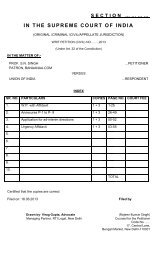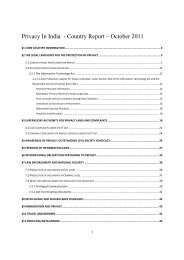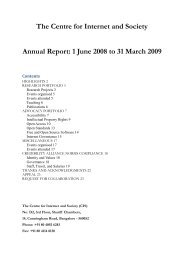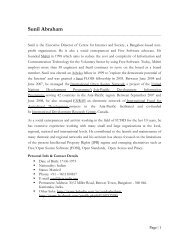Open Access to Scholarly Literature in India - Centre for Internet and ...
Open Access to Scholarly Literature in India - Centre for Internet and ...
Open Access to Scholarly Literature in India - Centre for Internet and ...
You also want an ePaper? Increase the reach of your titles
YUMPU automatically turns print PDFs into web optimized ePapers that Google loves.
tion <strong>in</strong> 1665, the pr<strong>in</strong>ted journal has become the primary vehicle of knowledge dissem<strong>in</strong>ation<br />
among scientists <strong>and</strong> scholars. (The field of computer science, where conferences are<br />
preferred, is an exception.) Scientists also meet other scientists, present papers at conferences,<br />
<strong>and</strong> write reports, monographs, textbooks, etc. But journals occupy a special place<br />
<strong>in</strong> scholarly communication, not only because they help scientists get the status of a permanent<br />
record <strong>for</strong> their new f<strong>in</strong>d<strong>in</strong>gs but also <strong>to</strong> establish ‘priority’, someth<strong>in</strong>g scientists<br />
guard jealously. Papers are given away <strong>for</strong> free <strong>and</strong> scientists do not normally get paid <strong>for</strong><br />
report<strong>in</strong>g their research <strong>in</strong> journals or <strong>for</strong> review<strong>in</strong>g papers received from journal edi<strong>to</strong>rs<br />
be<strong>for</strong>e they are published, whereas publishers pay them <strong>for</strong> writ<strong>in</strong>g textbooks <strong>and</strong> monographs.<br />
What are journals? They are noth<strong>in</strong>g but a collection of articles written by different<br />
authors appear<strong>in</strong>g periodically. They provide a plat<strong>for</strong>m <strong>for</strong> researchers <strong>in</strong> a field, sometimes<br />
very narrow (e.g. Journal of Raman Spectroscopy, Annals of Maxillofacial Surgery)<br />
<strong>and</strong> at others all embrac<strong>in</strong>g (Lancet cover<strong>in</strong>g all of medic<strong>in</strong>e, <strong>and</strong> Current Science,<br />
Nature <strong>and</strong> Science cover<strong>in</strong>g all of science), <strong>to</strong> announce their latest f<strong>in</strong>d<strong>in</strong>gs <strong>to</strong> other scientists<br />
around the world. In the early days there were a few scientists <strong>and</strong> a few journals,<br />
but <strong>in</strong> the past three centuries the number of scientists has <strong>in</strong>creased exponentially. S<strong>in</strong>ce<br />
the early 1700s, the number of scholars <strong>in</strong> scientific discipl<strong>in</strong>es has doubled every 15<br />
years, accord<strong>in</strong>g <strong>to</strong> de Solla Price. 9 And the questions they ask <strong>and</strong> the experiments they<br />
per<strong>for</strong>m have become more complex <strong>and</strong> have led <strong>to</strong> the evolution of new fields, subfields<br />
<strong>and</strong> research fronts which <strong>in</strong> turn have led <strong>to</strong> the emergence of a large number of<br />
professional societies <strong>and</strong> specialty journals. Obviously, there will be hundreds of thous<strong>and</strong>s<br />
of articles published every year <strong>and</strong> even larger number of references <strong>to</strong> earlier articles<br />
as it is an accepted convention <strong>to</strong> acknowledge ‘the shoulders of giants’.<br />
Journal edi<strong>to</strong>rs do not accept <strong>for</strong> publication all manuscripts they receive. They get<br />
them reviewed by other scientists with expertise <strong>in</strong> the field <strong>and</strong> this process is called<br />
peer review. Some manuscripts are recommended straightaway, some are found not good<br />
enough <strong>for</strong> publication <strong>and</strong> many are returned <strong>to</strong> authors with comments <strong>and</strong> suggestions<br />
<strong>for</strong> revision. “Peer review results <strong>in</strong> 1.3 million learned articles be<strong>in</strong>g published each year<br />
<strong>and</strong> it is fundamental <strong>to</strong> the <strong>in</strong>tegration of new research f<strong>in</strong>d<strong>in</strong>gs <strong>in</strong> hundreds of fields of<br />
<strong>in</strong>quiry <strong>and</strong> represents a unique, global collaboration <strong>in</strong> evaluation <strong>and</strong> quality assurance,”<br />
says the International Association of Scientific, Technical & Medical Publishers<br />
(STM). 10<br />
In the past more than 340 years, the scholarly journal has not changed much. No<br />
doubt there have been changes both <strong>in</strong> the way the content is presented <strong>and</strong> <strong>in</strong> the way<br />
9<br />
10<br />
de Solla Price D J (1963), Little Science, Big Science, Columbia University Press, New York.<br />
Peer Review Survey 2009: Prelim<strong>in</strong>ary F<strong>in</strong>d<strong>in</strong>gs (2009), Sense about Science,<br />
http://www.senseaboutscience.org.uk/<strong>in</strong>dex.php/site/project/395.<br />
Page | 6











